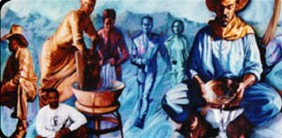When Marcus Akinlana was commissioned to create a large mural for the Denver International Airport (DIA), he selected Dibond Material for the painting substrate — material which has been used for a wide range of exhibit and display applications. Yet, to call him simply a “muralist” would shortchange the media and styles in which he likes to work. The mural at DIA even suggests as much, for a focal point of it is the relief figure of a gold miner. This hints of Akinlana’s sculptural work, while revealing the capability of his chosen material, as Dibond can be fabricated easily with a variety of common shop tools.
 Two sheets of .012″ aluminum bonded to a thermoplastic core, Dibond Material is a departure from many of the materials in which Akinlana has worked, which range from concrete castings to ceramics, glass tile, pastels, acrylics and more. He steadfastly refuses to be limited to one style or aesthetic, as well as one medium.
Two sheets of .012″ aluminum bonded to a thermoplastic core, Dibond Material is a departure from many of the materials in which Akinlana has worked, which range from concrete castings to ceramics, glass tile, pastels, acrylics and more. He steadfastly refuses to be limited to one style or aesthetic, as well as one medium.
Entitled “Mile High and Rising,” the DIA mural is 52 ft. long and 8 ft. high. It was intended to suggest “the black experience in Colorado and the West,” according to Akinlana. People depicted in the mural are black cowboys, construction workers, even modern business people, as well as legendary male and female personalities of the early West.
This New Orleans artist graduated from the Art Institute of Chicago in 1988. Yet his training is also in folk art, acquired from influences that include his grandfather and folk artist, Freddie Reynolds. Early in his career, he worked with the Chicago Public Art Group.
His work is intended to be very spiritual, Akinlana says, as it reflects “the spiritual power of God on Earth that is in every living thing.” Often his works are characterized by “rapid movement” and “complimentary vibrating color patterns.”
“We used approximately 450 sq. ft. of Dibond Material in the project at the Denver International Airport, Akinlana said. To fabricate the cantilevered miner in the Denver mural, we cut the sheets of Dibond Material with a jigsaw and backed it with fire retardant plywood.” The surface of the Dibond Material was scuffed to give it “tooth” before applying primer. “It worked very well,” he said. “We built a framing system and attached that to the wall and then attached the Dibond Material to the framing system.”
“I am always conducting research about new and exciting materials that I may be able to use for art and public art projects,” Akinlana added. “I was impressed with the light weight and longevity of 3mm Dibond Material and the technical department’s excellent customer service.” A significant factor in the success of the project was the fabrication ease of the material — ranging from paint application to the cutout of the relief figure. Akinlana said he was previously aware of Sintra Material, rigid board of moderately expanded plastic material that also has been used by others in art projects, as well as commercial projects of an exhibit and display nature. Both materials are domestically manufactured by the Benton, Kentucky plant of 3A Composites USA Inc.
Mile High & Rising’ was sponsored by the Mayor’s Office of Art Culture and Film for the city and county of Denver and administered by Ulozi Arts Center,” said Akinlana. “Ulozi, in conjunction with Denver community members, decided what the theme of the project would be. Ulozi is a multi-talented, multifaceted artist collective located in Denver.”
“We will also use approximately 1,250 sq. ft. of Dibond Material in a project for the Philadelphia International Airport,” Akinlana said. “The name of the project is ‘Flyventures.’ It depicts the adventurous development of aviation technology. It consists of two murals and sculptural installations on the east and west walls and adjoining ceilings of the first floor ticket lobby of terminal one of the airport. The sculptures will be cast in fiberglass and cantilevered from the walls 9 ft. above the floor. The first sculpture will be of an ancient man flying a kite, and the second sculpture will be of an astronaut. They will be integrated into the overall mural design and, in fact, look as if they are ‘coming out’ of the wall murals and connecting into ceiling murals with cables that represent the kite’s line and the astronaut umbilical cord. Images will include 30-ft.-long planes, sky divers, helicopters, ancient Greek myths of light, barnstormers, etc. Anticipated completion date is late spring 2002.”
The name of Akinlana’s public art company is WON Mural Society, and Fatu Akinlana, Marcus’ wife, is the Administrative Director. She is responsible for “numerous functions” he said, ranging from brainstorming to overseeing all administrative tasks. “She is a full partner in the business and has built the company up since 1994. The artist usually gets all of the credit, but all of the projects here are a result of both our efforts, as well as numerous studio assistants that we hire on a per project basis.”

